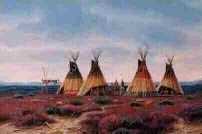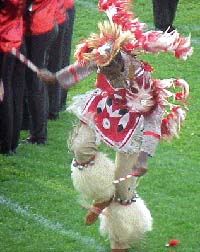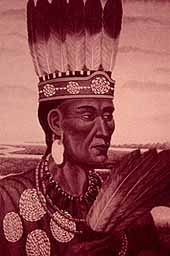 Another Stereotype of the Month entry:
Another Stereotype of the Month entry:
 Another Stereotype of the Month entry:
Another Stereotype of the Month entry:
I am deeply concerned when students studying First Nations come to the conclusion that the "Iroquois finished off the Huron", design teepees as part of their study of longhouse people, and give each other false names. Something is terribly wrong within this school.
Jumping into cultural deep end
Students live, learn about lives of "original peoples' of America
Saturday, December 1
By Susan Baldrige
New Era Staff Writer
http://www.lancasteronline.com/newera_news/indianba.htm
It was difficult enough being an Indian in the Huron tribe during the 17th century—surviving day to day, making clay pots, building fires from scratch.
"And then the Americans came along," said Jason Long, shaking his head. "It was a hard life."
Jason, also known as Striking Scorpion, should know.
He and his 31 classmates in the sixth grade at Lancaster Mennonite spent six weeks studying "original peoples" of Canada, Mexico and Central America.
The study culminated in a day-long celebration Friday of tepee building, fire making, elk roasting, dancing and game playing.
From early in the morning, families worked on tepees they had designed. They built fires with grates over them to cook on and they witnessed one student re-enacting a native dance while in costume.
And the kids and their parents didn't let a little rain stop the festivities.
"Hey, Indians didn't stop when it rains," said their teacher, Janice Southwick, who has been leading both the study and the celebration for nine years.
Southwick, also called Jumping Frog, and her fellow sixth grade teacher, Jennifer McGowan, gave the students as close to an authentic cultural experience as they possibly could.
"She jumped in with both feet," Southwick said of McGowan, a first-year teacher.
Southwick said for the past two years, her class has started the original peoples unit with a visit to the Rankokus Indian Reservation in Rancocas, N.J.
"People there come from all different areas," explained Southwick. "They hold an Indian Arts festival, they have Wisdom Keepers, real tepees and an expert that shows the kids real birds of prey."
Southwick said her kids had the opportunity to ask questions of the descendants of some of the original tribes that lived on the continent.

After that inspiration, the students chose one tribe from 16 different tribes on which they would focus intensely. They each wrote a research paper on the tribe he or she had selected.
Six weeks later, after extensive use of internet research and 100 books checked out from the Lancaster County Library, each student had become something of an expert on his or her tribe.
According to Jason—eh, Stinging Scorpion—the invasion of the Americans caused the Huron Indian hunting grounds to be overused.
"The Hurons started trading furs with the French traders," he explained. "Eventually when the Americans came into the area, they killed all the animals for their hides," Jason said. "They had to go out into where other tribes were living. The Iroquois finished them off."
Kicking Legs, a.k.a. Katie Ruth, couldn't think of much about authentic Indian life that appealed to her.
"They didn't have technology so that would be a little boring," said Katie. "And they were always attacking or getting attacked."
Katie said the Sioux dances seemed like fun and she loved learning about their native rituals although they didn't appeal to her much.
"One of the Sioux rituals was, for a boy to become a man, he would sit in a shallow pit of water for three days without eating and try to see a vision," said the sixth grader.
They also liked to gamble a lot," she said. "They would throw beans in the air and bet on which ones would land in a certain space."
"The good and the bad," said Southwick of the information gathered by students. "Both the positive and the negative. It gives them a realistic picture and helps them to see people as they are.
"We need to relate to one another on an equal level if we're going to understand one another," said Southwick.
She described the in-depth study as a multi-cultural perspective, not just a traditional white American perspective on the history, but one that explores both the history and the civilization of native groups of people.
"It's an integrated unit so the students can see how everything relates to everything else," said Southwick. "It's a real-life context, not just a group of people as an independent entity, but a study of how civilizations interacted and what became of them."
Southwick said she believes integrating several subjects into a unit helps children retain the information.
"And they end up loving the groups they studied," she said. "I have former students who have gone to work on Indian reservations and students who have come back and told me how much they loved this," Southwick said.
"That touches my heart. I can't ask for any more than that."
©2001 Lancaster Newspapers, Inc.
SCHOOL CONTACT:
Lancaster Mennonite Middle School
2176 Lincoln Highway
East Lancaster, PA 17602
(717) 299-0436
office@lmhs.com

Rob's comment
A "multicultural perspective"...hey, that's my line!
It sounds like the class indeed jumped into the "cultural deep end." But did they sink or swim?
Having a student imitate a Native dance in costume worries me. After studying Native cultures for a decade, I wouldn't presume I could learn a dance in six weeks.
The students studied one of 16 tribes, so it probably made sense if some built tipis and learned about Sioux rituals while others focused on the Iroquois and Huron. The question is whether the kids truly learned the differences between the tribes.
I see a more subtle flaw than the ones mentioned. The kids apparently got the message that Indians were primitive. "Didn't have technology"...what is building a tipi or cooking a fire over a grate but a form of technology? These forms may seem simple, but put an Indian out on the plain with his "primitive" tools and apparatus and the student with her Swatch, Air Jordan sneakers, MP3 player, and PDA. Guess which one survives the longest without help.
It sounds like they didn't study any of the great Indian civilizations, such as the Aztecs or Inca. If that's the case, no wonder the kids had a dim view of Indian technology. It sounds like they studied Plains Indian technology, which was well-adapted to Plains Indian life. It was relatively simple because nomadic people didn't need and couldn't carry much technology.
The whole idea that Indian life was boring shows the students haven't truly appreciated the lives they studied. If you were a traditional Indian, you'd learn about every plant, animal, rock, river, cloud, star, and so forth. You'd be fully immersed in your world and wouldn't need the artificial stimulation of videos or music. Your life would be fascinating to you even if strangers didn't understand it.
Ironically, it's the modern student who complains about being bored three times a week and every day in summer. In contrast, I'll bet traditional people rarely found their lives boring. In fact, I wouldn't be surprised if they didn't have a word for "boredom" in their languages.
That's what I mean by a multicultural perspective. It's not studying a culture for six weeks and learning it has a few quaint objects and practices, but is ultimately weird and boring. It's realizing that the people who inhabit those cultures are as fully alive, aware, and involved as everyone else.
A good idea for this class might be to read some of the narratives written by Indian captives. Almost uniformly, white people carried off by Indians wanted to stay with their captors when they were "rescued." How could that be if Indian cultures were so primitive and boring?
Answering questions like that might bring the names, dances, and tipis into focus. Arts and crafts are one thing, but they don't give the full flavor of a culture. You need a culture's worldview for that.
Another idea for perspective
Correspondent Ishgooda suggests "the kids do a week on primitive Europeans from the same time period." No electricity, no plumbing, no central heating or air conditioning. Infectious disease and vermin accepted as part of life, back-breaking labor from childhood, and baths taken only once a year. (In contrast to the unwashed Europeans, Indians tended to be scrupulously clean.)
As Ishgooda puts it, "Let's see which 'primitive lifestyle' they prefer." The point, of course, is that Native cultures evolved with the times like any others. Indians were quick to take advantage of horses, guns, and mass-produced implements, just as Euro-Americans were quick to take advantage of corn, tobacco, canoes, parkas, and adobe.
A study program that paints Indians as frozen in time while Euro-Americans have evolved is implicitly saying the latter are culturally superior. The better comparison is like vs. like. As history shows, the European colonizers were dependent on their Native hosts even as their diseases and weapons ravaged them.
Related links
White Americans Play "Indian," Professor Says
YMCA Indian Guides
WASPs in kelp headdresses
|
. . . |

|
All material © copyright its original owners, except where noted.
Original text and pictures © copyright 2007 by Robert Schmidt.
Copyrighted material is posted under the Fair Use provision of the Copyright Act,
which allows copying for nonprofit educational uses including criticism and commentary.
Comments sent to the publisher become the property of Blue Corn Comics
and may be used in other postings without permission.